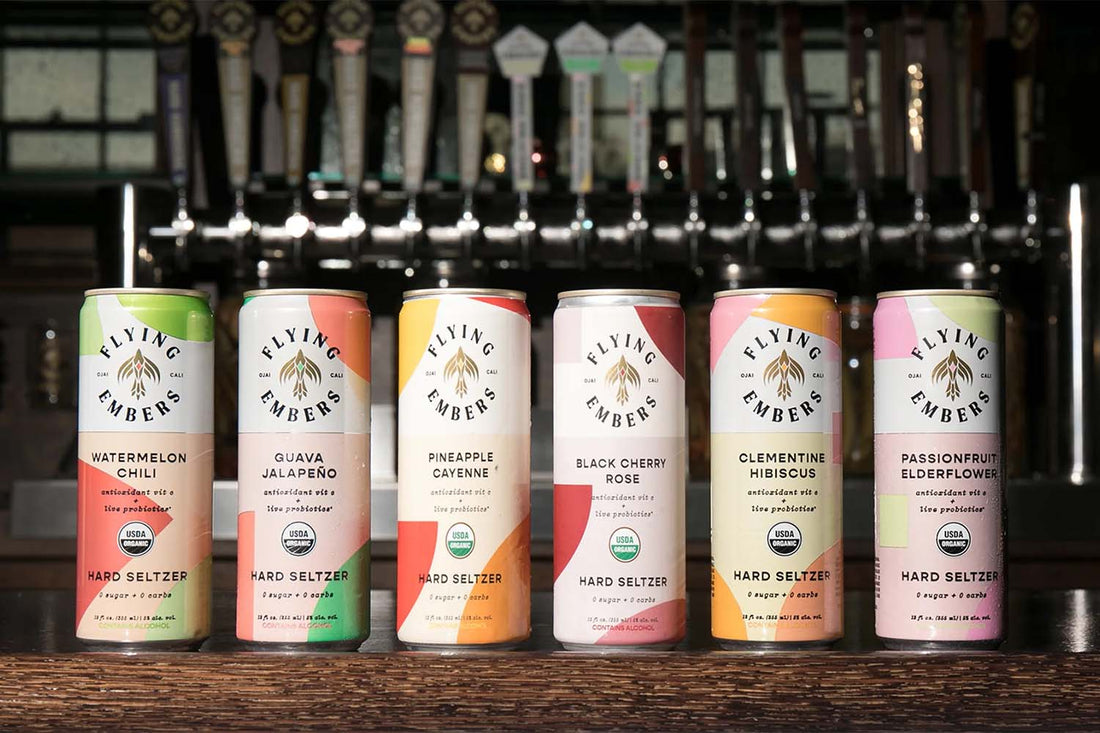When you think of kombucha, you might visualize the tangy drink lined up on grocery store shelves in glass bottles. We hate to break it to you, but you might want to adjust that fantasy.
Why? While you might be used to seeing kombucha in glass bottles, aluminum cans are becoming the new preferred packaging. With its preservation abilities and reduced environmental impacts, the future of booch is canned.
Why Drink Kombucha From a Can? 6 Reasons
The Impact of Bottles on the Environment
Glass might be recyclable, but it poses a significant threat to the environment — possibly even more than plastic. Both plastic and glass take hundreds of years to decompose and can harm wildlife if they end up in nature.
Glass is made from a combination of raw materials, all of which have to be mined. Mining is not an eco-friendly process, harming wildlife, ecosystems, water, and air along the way. The extraction of raw materials also uses a lot of energy, leaving behind a slew of pollution in its wake.
Turning raw materials into glass isn’t energy-efficient either. Glass is made by heating the mined materials to volcanic-level temperatures — we’re talking up to 1,700 degrees celsius. Once heated, the mixture is cooled back down to get glass. The heating and cooling process requires a lot of energy and can further contribute to pollution.
On top of that, glass is heavy and breakable, making its transportation another energy-eating hassle, but we’ll get more into that later.
Cans Are Easier To Recycle
We’ve all heard that we should reduce, reuse, and recycle. When it comes to our kombucha, we want to make sure that all our packaging is recyclable and, better yet, easy to recycle. That’s why we use aluminum cans for all of our drinks.
Aluminum is easily recycled; in fact, we can recycle 100% of an aluminum can and reuse it for new cans. Because it’s so easy to reuse aluminum, less aluminum has to be mined, reducing the destructive effects of mining on the earth.
Unlike glass, aluminum won’t shatter or break easily, so it’s more likely to end up in a new product than broken into thousands of shards somewhere. This property is a huge contributor to why aluminum cans are the most recycled item on the planet.
Cans Cost Less To Ship Worldwide
We’ve all had to pay shipping and handling fees at some point — and it’s not always cheap. To cut down on our costs (and yours), we use aluminum cans over glass bottles.
What makes aluminum cheaper to transport? It’s the same thing that makes aluminum easier to recycle — aluminum doesn’t break as easily. Aluminum cans can be packed closely together, so more cans can be transported at once.
Glass, on the other hand, requires more cushioning between bottles in case the delivery truck hits a bump in the road. Bottles have to be more spaced out, so fewer bottles can be transported in a single delivery.
And if something breaks, the kombucha spills out and has to be brewed, packaged, and transported all over again, using more energy in the process. On top of that, glass is heavy and requires more overall energy to transport, furthering its carbon footprint.
Shipping aside, more lightweight packaging makes all transport easier. Whether carrying cans into your house from your car or packing them for a picnic, the lightweight, space-saving nature of cans makes them the obvious choice for any adventure.
Cans Preserve Kombucha’s Refreshing Taste
Another reason we love cans? They’re the best for keeping our booch tasting fresh and flavorful. We want every drop of our kombucha to taste just as fresh as it does when we finish fermenting, and cans are the best option for preserving our unique, innovative flavors.
How do cans preserve flavor better? Well, one reason is that, unlike transparent glass bottles, aluminum cans don’t allow any light near the liquid inside. We love extra vitamin D on our shoulders, but not near our booch — light can actually alter the taste.
Another enemy to perfect flavors? Air. Bottles with lids may let in more air than the pop-top tabs of cans, which adds more risk of excess air affecting tastes.
Glass Is a Fast-Depleting Resource
Glass might seem like a common material, but it doesn’t grow on trees. Glass is actually made from sand, soda ash, and limestone, and, well, they don’t grow on trees either. These materials must be mined, and the process isn’t too kind to the environment.
Mines can disrupt ecosystems for plants and animals with noise pollution, water pollution, and developing the land to a point where it’s unlivable for wildlife.
Both mining and the glassmaking process use a lot of energy, further straining the environment. When the sand, soda ash, and limestone are heated up and melted back down to turn them into glass, a lot of energy is used in the process.
The worst part? The materials that make up glass are nonrenewable — once we run out, we’re out. Glass can be recycled and reused, but it doesn’t recycle as easily as aluminum. When it comes to sustainability, it makes more sense to use cans over glass.
Learning From the Craft Beer Can Revolution
One of the best things about beverages is that there are so many different drinks to try. Drinking is an adventurous experience, and the surge in craft beers’ popularity proves that people love trying new drink experiences. And one of the easiest ways to enhance a unique drink is with an equally memorable can.
Unlike big beer producers, craft beers tend to lean towards cans over glass bottles. You might’ve walked through a craft beer section of a store and noticed the shelves dotted with brightly colored cans with eye-catching artwork. With craft beers, the drink experience starts with the visual exterior to set the tone.
While we’re more into hard kombucha than craft beer, we share the same desire to create drinks that are carefully crafted to enhance simple pleasures. We put our own twist on colorful cans so that the exterior of our drinks reflects all the goodness waiting inside. You might not want to judge a book by its cover, but judging our kombucha by our vibrant, lively cans is okay with us.
Canned Hard Kombuchas You Have To Try
Suddenly craving a can of hard kombucha in your hand? Us too. Here are a few recommendations of some of our favorite brews to lighten your mood and liberate your spirits.
Orange Passion Mimosa: Bright, Smooth, and Juicy
Never had hard kombucha before? Totally okay. If you’re just getting into kombucha, why not start off with a familiar flavor?
Our Orange Passion Mimosa has the juicy orange flavor of a traditional mimosa, complemented by the tangy taste of kombucha. We’ve added notes of passionfruit and guava for an additional tropical twist.
Grapefruit Thyme: Tangy, Aromatic, and Fruity
Kombucha is known for its refreshing, tangy taste, and we’ve created a drink to perfectly complement those qualities. Our Grapefruit Thyme hard kombucha starts with the spirited, aromatic flavors of pink grapefruit that reflect the characteristic tang of kombucha. It’s followed by a crisp hint of thyme for a refreshingly finish.
If you need some new Instagram content, look no further. All the goodness is wrapped up in a white can with grapefruit pink accents.
Pineapple Chili: Bold, Bright, and Tropical
If you’re feeling extra adventurous, reach for a can of our Pineapple Chili hard kombucha. This drink starts with the boldly sweet flavor of pineapple, gracefully interrupted by the heat of spiced chili for a blissfully balanced brew.
Canned Kombucha Is Here To Stay
As the world moves forward on the path to sustainability, canned kombucha will continue as the most eco-friendly way to package your favorite booch or beverage. And since aluminum cans can be recycled over and over, you can enjoy all the kombucha you want without adding to your carbon footprint.
Sources:
Glass Bottles Have a Larger Environmental Impact Than Plastic Bottles- Study | Earth.Org
Let's Compare: Cans vs. Glass vs. Plastic Bottles | Greenpop
Plastic vs. Aluminum vs. Glass: Which Packaging Should You Choose? | RecycleNation
Why Canned Beer Is Way Better Than Bottled Beer | Business Insider
Is glass harmful to the environment? | The Waste Management & Recycling Blog

